Sustainable Synergies between the Cultural and Tourism Industries: An Efficiency Evaluation Perspective
Abstract
1. Introduction
2. Literature Review
3. Methodology
3.1. Analytical Framework and Data
3.2. SBM-DEA Model
3.3. Malmquist Index of TFP
3.4. Model of the Coupling Coordination Degree
4. Results and Findings
4.1. Evaluation of Efficiency: The Technical Efficiency of CTI
4.1.1. The Temporal and Spatial Distributions of CTI Efficiency
4.1.2. The Role of Cultural Industries in CTI Efficiency
4.2. Evaluation of the Sustainable Growth of Productivity: The Malmquist Index and its Decomposition
4.3. Evaluation of Coordination: The Coupling Coordination Degree of CTI
4.3.1. General Characteristics of the Coupling Coordination Degree
4.3.2. Comparison of the Coupling Coordination Degree and CTI Efficiency
4.3.3. Comparison of the Coupling Coordination Degree and Malmquist Index
5. Conclusions and Implications
Author Contributions
Funding
Conflicts of Interest
References
- Petroman, I. Types of cultural tourism. Sci. Pap. Anim. Sci. Biotechnol. 2013, 46, 385–388. [Google Scholar]
- Bonet, L. Cultural tourism. In A Handbook of Cultural Economics; Towse, R., Ed.; Edward Elgar: Cheltenham, UK, 2003; pp. 187–193. [Google Scholar]
- Zhuang, X.; Yao, Y.; Li, J.J. Sociocultural Impacts of Tourism on Residents of World Cultural Heritage Sites in China. Sustainability 2019, 11, 840. [Google Scholar] [CrossRef]
- Gjorgievski, M.; Melles Trpkova, S. Movie induced tourism: A new tourism phenomenon. UTMS J. Econ. 2012, 3, 97–104. [Google Scholar]
- Craik, J. Fashion, Tourism and Global Culture. In The Handbook of Fashion Studies; Black, S., Haye, A.D.L., Entwistle, J., Rocamora, A., Root, R.A., Thomas, H., Eds.; Bloomsbury Academic: Oxford, UK, 2013; pp. 364–380. [Google Scholar]
- Picard, M. ‘Cultural tourism’ in Bali: National integration and regional differentiation. In Tourism in South-East Asia; Hitchcock, M., King, V.T., Parnwell, J.G., Eds.; Routledge: London, UK, 1993; pp. 71–98. [Google Scholar]
- Loulanski, T.; Loulanski, V. The sustainable integration of cultural heritage and tourism: A meta-study. J. Sustain. Tour 2011, 19, 837–862. [Google Scholar] [CrossRef]
- United Nations World Tourism Organization (UNWTO). Report on Tourism and Culture Synergies; UNWTO: Madrid, Spain, 2018; p. 20. [Google Scholar]
- Borowiecki, K.J.; Castiglione, C. Cultural participation and tourism flows: An empirical investigation of Italian provinces. Tour. Econ. 2014, 20, 241–262. [Google Scholar] [CrossRef]
- Jiménez-Beltrán, F.; López-Guzmán, T.; González Santa Cruz, F. Analysis of the relationship between tourism and food culture. Sustainability 2016, 8, 418. [Google Scholar] [CrossRef]
- Barbieri, C.; Mahoney, E. Cultural tourism behaviour and preferences among the live-performing arts audience: An application of the univorous–omnivorous framework. Int. J. Tour. Res. 2010, 12, 481–496. [Google Scholar] [CrossRef]
- Fuchs, M. Strategy development in tourism destinations: A DEA approach. Pozn. Univ. Econ. Rev. 2004, 4, 52–73. [Google Scholar]
- Bosetti, V.; Cassinelli, M.; Lanza, A. Benchmarking in tourism destinations; keeping in mind the sustainable paradigm. In Advances in Modern Tourism Research; Matias, A., Nijkamp, P., Neto, P., Eds.; Physica-Verlag of Springer: Heidelberg, Germany, 2007; pp. 165–180. [Google Scholar]
- Zhang, Y.; Zhu, H. Empirical Research on Coupling Coordination of Cultural Industry and Tourism Industry in Southwest China. Areal Res. Dev. 2013, 2, 16–21. (In Chinese) [Google Scholar]
- Yang, C.H.; Lin, H.L.; Han, C.C. Analysis of international tourist arrivals in China: The role of World Heritage Sites. Tour. Manag. 2010, 31, 827–837. [Google Scholar] [CrossRef]
- WTCF Report on World Tourism Economy Trends of 2019. Available online: https://cn.wtcf.org.cn/xsyj/lhhbg/201901153839829.html (accessed on 1 October 2019).
- UNESCO World Heritage List. Available online: http://whc.unesco.org/en/list/ (accessed on 1 October 2019).
- Yang, J.T. Legislative Situation and Construction of Legal System in the Development of Culture Industry. J. Beijing Union Univ. (Humanit. Soc. Sci.) 2012, 10, 88–94. (In Chinese) [Google Scholar]
- Cheng, J.; Lu, L.; Zhu, F.B. On the Study Progress of Tourism Industrial Merging and Its Enlightenment. Tour. Trib. 2011, 26, 13–19. (In Chinese) [Google Scholar]
- China has selected 134 historical and cultural cities and 528 historical and cultural towns and villages. (In Chinese). Available online: http://www.ce.cn/xwzx/gnsz/gdxw/201812/25/t20181225_31112932.shtml (accessed on 19 October 2019).
- China Excellent Tourism City Directory. (In Chinese). Available online: https://web.archive.org/web/20130115122030/http://cnta.gov.cn/html/2010-5/2010-5-5-15-23-87301.html (accessed on 19 October 2019).
- The added value of national tourism and related industries accounted for 4.53% of GDP in 2017. (In Chinese). Available online: http://www.stats.gov.cn/tjsj/zxfb/201901/t20190118_1645545.html (accessed on 19 October 2019).
- The added value of China’s culture and related industries accounted for 4.2% of GDP in 2017. (In Chinese). Available online: http://www.stats.gov.cn/tjsj/zxfb/201810/t20181010_1626867.html (accessed on 19 October 2019).
- Adorno, T.W.; Rabinbach, A.G. Culture industry reconsidered. New Ger. Crit. 1975, 6, 12–19. [Google Scholar] [CrossRef]
- Adorno, T.W. The Culture Industry: Selected Essays on Mass Culture; Routledge: London, UK, 1991; pp. 1–27. [Google Scholar]
- Adorno, T.W.; Horkheimer, M. The culture industry: Enlightenment as mass deception. In Stardom and Celebrity: A Reader; Redmond, S., Holmes, S., Eds.; SAGE: London, UK, 2007; pp. 34–43. [Google Scholar]
- Alsos, G.A.; Eide, D.; Madsen, E.L. Introduction: Innovation in tourism industries. In Handbook of Research on Innovation in Tourism Industries; Alsos, G.A., Eide, D., Madsen, E.L., Eds.; Edward Elgar: Cheltenham, UK, 2014; pp. 1–24. [Google Scholar]
- Craik, J. The culture of tourism. In Touring Cultures; Rojek, C., Urry, J., Eds.; Routledge: London, UK, 2002; pp. 123–146. [Google Scholar]
- Throsby, D. Cultural capital. J. Cult. Econ. 1999, 23, 3–12. [Google Scholar] [CrossRef]
- Herrero-Prieto, L.C.; Gómez-Vega, M. Cultural resources as a factor in cultural tourism attraction:Technical efficiency estimation of regional destinations in Spain. Tour. Econ. 2017, 23, 260–280. [Google Scholar] [CrossRef]
- Richards, G. Production and consumption of European cultural tourism. Ann. Tour. Res. 1996, 23, 261–283. [Google Scholar] [CrossRef]
- Hughes, H. Arts, Entertainment and Tourism; Butterworth-Heinemann: Oxford, UK, 2000; pp. 61–63. [Google Scholar]
- Hughes, H.L. Culture and tourism: A framework for further analysis. Manag. Leis. 2002, 7, 164–175. [Google Scholar] [CrossRef]
- Smith, M.K. Issues in Cultural Tourism Studies; Routledge: London, UK, 2003; pp. 4–7. [Google Scholar]
- Andreasen, A.R.; Belk, R.W. Predictors of attendance at the performing arts. J. Consum. Res. 1980, 7, 112–120. [Google Scholar] [CrossRef]
- Kirchberg, V. Museum visitors and non-visitors in Germany: A representative survey. Poetics 1996, 24, 239–258. [Google Scholar] [CrossRef]
- Herbert, D. Literary places, tourism and the heritage experience. Ann. Tour. Res. 2001, 28, 312–333. [Google Scholar] [CrossRef]
- Artal-Tur, A.; Briones-Peñalver, A.J.; Villena-Navarro, M. Tourism, cultural activities and sustainability in the Spanish Mediterranean regions: A probit approach. Tour. Manag. Stud. 2018, 14, 7–18. [Google Scholar] [CrossRef]
- Dolnicar, S. Activity-Based Market Sub-Segmentation of Cultural Tourists. J. Hosp. Tour. Manag. 2002, 9, 94–105. [Google Scholar]
- Zeppel, H.; Hall, C.M. Arts and heritage tourism. In Special Interest Tourism; Weiler, B., Hall, C.M., Eds.; Belhaven Press: London, UK, 1992; pp. 47–68. [Google Scholar]
- Medina, L.K. Commoditizing culture: Tourism and Maya identity. Ann. Tour. Res. 2003, 30, 353–368. [Google Scholar] [CrossRef]
- Richards, G. Tourism Trends: The Convergence of Culture and Tourism; Working Paper, Academy for Leisure; NHTV University of Applied Sciences: Brenda, The Netherlands, 2014. [Google Scholar]
- Zhang, H.; Wang, Z. Research on Industrial Convergence Development of Tourism Industry and Cultural Industry. Resour. Develpment Mark. 2010, 26, 322–326. (In Chinese) [Google Scholar]
- Pope, J.; Annandale, D.; Morrison-Saunders, A. Conceptualising sustainability assessment. Environ. Impact Assess. Rev. 2004, 24, 595–616. [Google Scholar] [CrossRef]
- Girard, L.F.; Nijkamp, P. Cultural Tourism and Sustainable Local Development; Ashgate: Surrey, UK, 2009; pp. 13, 22, 52. [Google Scholar]
- Berry, S.; Shephard, G. Cultural Heritage Sites and Their Visitors: Too Many for Too few. In Cultural Attractions and European Tourism; Richards, G., Ed.; CABI: Oxon, UK, 2001; pp. 159–172. [Google Scholar]
- Russo, A.P. The “vicious circle” of tourism development in heritage cities. Ann. Tour. Res. 2002, 29, 165–182. [Google Scholar] [CrossRef]
- Richards, G. Cultural tourism: A review of recent research and trends. J. Hosp. Tour. Manag. 2018, 36, 12–21. [Google Scholar] [CrossRef]
- Noonan, D.S.; Rizzo, I. Economics of cultural tourism: Issues and perspectives. J. Cult. Econ. 2017, 41, 95–107. [Google Scholar] [CrossRef]
- Srakar, A.; Vecco, M. Ex-ante versus ex-post: Comparison of the effects of the European Capital of Culture Maribor 2012 on tourism and employment. J. Cult. Econ. 2017, 41, 197–214. [Google Scholar] [CrossRef]
- Cracolici, M.F.; Nijkamp, P.; Rietveld, P. Assessment of Tourism Competitiveness by Analysing Destination Efficiency. Tour. Econ. 2008, 14, 325–342. [Google Scholar] [CrossRef]
- Barros, C.P.; Botti, L.; Peypoch, N.; Robinot, E.; Solonandrasana, B.A.; George, A. Performance of French destinations: Tourism attraction perspectives. Tour. Manag. 2011, 32, 141–146. [Google Scholar] [CrossRef]
- Benito, B.; Solana, J.; López, P. Determinants of Spanish Regions’ Tourism Performance: A Two-Stage, Double-Bootstrap Data Envelopment Analysis. Tour. Econ. 2014, 20, 987–1012. [Google Scholar] [CrossRef]
- Cuccia, T.; Guccio, C.; Rizzo, I. The effects of UNESCO World Heritage List inscription on tourism destinations performance in Italian regions. Econ. Model. 2016, 53, 494–508. [Google Scholar] [CrossRef]
- Cuccia, T.; Guccio, C.; Rizzo, I. UNESCO sites and performance trend of Italian regional tourism destinations: A two-stage DEA window analysis with spatial interaction. Tour. Econ. 2017, 23, 316–342. [Google Scholar] [CrossRef]
- Assaf, A.G.; Josiassen, A. Identifying and Ranking the Determinants of Tourism Performance: A Global Investigation. J. Travel Res. 2011, 51, 388–399. [Google Scholar] [CrossRef]
- Assaf, A.G.; Tsionas, M. The estimation and decomposition of tourism productivity. Tour. Manag. 2018, 65, 131–142. [Google Scholar] [CrossRef]
- Basso, A.; Funari, S. A quantitative approach to evaluate the relative efficiency of museums. J. Cult. Econ. 2004, 28, 195–216. [Google Scholar] [CrossRef]
- Bishop, P.; Brand, S. The efficiency of museums: A stochastic frontier production function approach. Appl. Econ. 2003, 35, 1853–1858. [Google Scholar] [CrossRef]
- Liu, G.; Yang, W. DEA-based investment efficiency model and a positive analysis of the cultural tourism industry. Tour. Trib. 2013, 28, 77–84. (In Chinese) [Google Scholar]
- Rawley, E. Diversification, coordination costs, and organizational rigidity: Evidence from microdata. Strateg. Manag. J. 2010, 31, 873–891. [Google Scholar] [CrossRef]
- Zellner, A.; Kmenta, J.; Dreze, J. Specification and estimation of Cobb-Douglas production function models. Econom. J. Econom. Soc. 1966, 34, 784–795. [Google Scholar] [CrossRef]
- Charnes, A.; Cooper, W.W.; Rhodes, E. Measuring the efficiency of decision making units. Eur. J. Oper. Res. 1978, 2, 429–444. [Google Scholar] [CrossRef]
- Tone, K. Slacks-based measure of efficiency. In Handbook on Data Envelopment Analysis; Cooper, W.W., Seiford, L.M., Zhu, J., Eds.; Springer: Boston, MA, USA, 2011; pp. 195–209. [Google Scholar]
- Xu, D.; Huang, Z.F.; Hu, X.H.; Lv, L.; Cao, F.D. The Spatial Pattern Evolution and Its Influencing Factors of County-Scale Tourism Efficiency in Zhejiang Province. Econ. Geogr. 2018, 38, 197–207. (In Chinese) [Google Scholar]
- Malmquist, S. Index numbers and indifference surfaces. Trab. De Estad. Y De Investig. Oper. 1953, 4, 209–242. [Google Scholar] [CrossRef]
- Färe, R.; Grosskopf, S.; Lindgren, B.; Roos, P. Productivity changes in Swedish pharamacies 1980–1989: A non-parametric Malmquist approach. J. Product. Anal. 1992, 3, 85–101. [Google Scholar] [CrossRef]
- Pastor, J.T.; Lovell, C.K. A global Malmquist productivity index. Econ. Lett. 2005, 88, 266–271. [Google Scholar] [CrossRef]
- Färe, R.; Grosskopf, S.; Norris, M.; Zhang, Z. Productivity growth, technical progress, and efficiency change in industrialized countries. Am. Econ. Rev. 1994, 84, 66–83. [Google Scholar]
- Zhang, Y.; Su, Z.; Li, G.; Zhuo, Y.; Xu, Z. Spatial-Temporal Evolution of Sustainable Urbanization Development: A Perspective of the Coupling Coordination Development Based on Population, Industry, and Built-Up Land Spatial Agglomeration. Sustainability 2018, 10, 1766. [Google Scholar] [CrossRef]
- Liu, Y.; Li, R.; Song, X. Analysis of Coupling Degrees of Urbanization and Ecological Environment in China. J. Nat. Resour. 2005, 20, 105–112. [Google Scholar]
- Guidance on Promoting the Integration of Culture and Tourism. (In Chinese). Available online: http://www.gov.cn/zwgk/2009-09/15/content_1418269.htm (accessed on 19 September 2019).
- The Press Conference Was Held on “Guidance on Promoting the Integration of Culture and Tourism”. (In Chinese). Available online: http://www.gov.cn/gzdt/2009-09/24/content_1425087.htm (accessed on 19 September 2019).
- United Nations Department of Economic and Social Affairs (UN/DESA). World Economic Situation and Prospects 2013; United Nations: New York, NY, USA, 2013. [Google Scholar]
- Li, S.; Xing, F.; Zhang, L. The influence of tourism industrial agglomeration on the regional tourism industry efficiency: A panel data analysis of provinces in China. World Reg. Stud. 2017, 26, 134–146. (In Chinese) [Google Scholar]
- Archer, B.; Cooper, C.; Ruhanen, L. The positive and negative impacts of tourism. In Global Tourism, 3rd ed.; Theobald, W.F., Ed.; Elsevier: Burlington, VT, USA, 2005; pp. 79–102. [Google Scholar]
- Li, Z.; Yang, W.; Wang, C.; Zhang, Y.; Yuan, X. Guided High-Quality Development, Resources, and Environmental Forcing in China’s Green Development. Sustainability 2019, 11, 1936. [Google Scholar] [CrossRef]
- Cole, S. Synergy and congestion in the tourist destination life cycle. Tour. Manag. 2012, 33, 1128–1140. [Google Scholar] [CrossRef]
- Su, Y.-W.; Lin, H.-L. Analysis of international tourist arrivals worldwide: The role of world heritage sites. Tour. Manag. 2014, 40, 46–58. [Google Scholar] [CrossRef]
- Lin, Y.; Deng, N.; Gao, H. Research on Technological Innovation Efficiency of Tourist Equipment Manufacturing Enterprises. Sustainability 2018, 10, 4826. [Google Scholar] [CrossRef]
- Song, M.; Zheng, W.; Wang, S. Measuring green technology progress in large-scale thermoelectric enterprises based on Malmquist–Luenberger life cycle assessment. Resour. Conserv. Recycl. 2017, 122, 261–269. [Google Scholar] [CrossRef]
- Andriotis, K. Community groups’ perceptions of and preferences for tourism development: Evidence from Crete. J. Hosp. Tour. Res. 2005, 29, 67–90. [Google Scholar] [CrossRef]
- Tosun, C.; Timothy, D.J.; Öztürk, Y. Tourism growth, national development and regional inequality in Turkey. J. Sustain. Tour 2003, 11, 133–161. [Google Scholar] [CrossRef]
- Fuest, C.; Huber, B. Can regional policy in a federation improve economic efficiency? J. Public Econ. 2006, 90, 499–511. [Google Scholar] [CrossRef]
- Alegre, I.; Berbegal-Mirabent, J. Social innovation success factors: Hospitality and tourism social enterprises. Int J. Contemp Hosp. M 2016, 28, 1155–1176. [Google Scholar] [CrossRef]
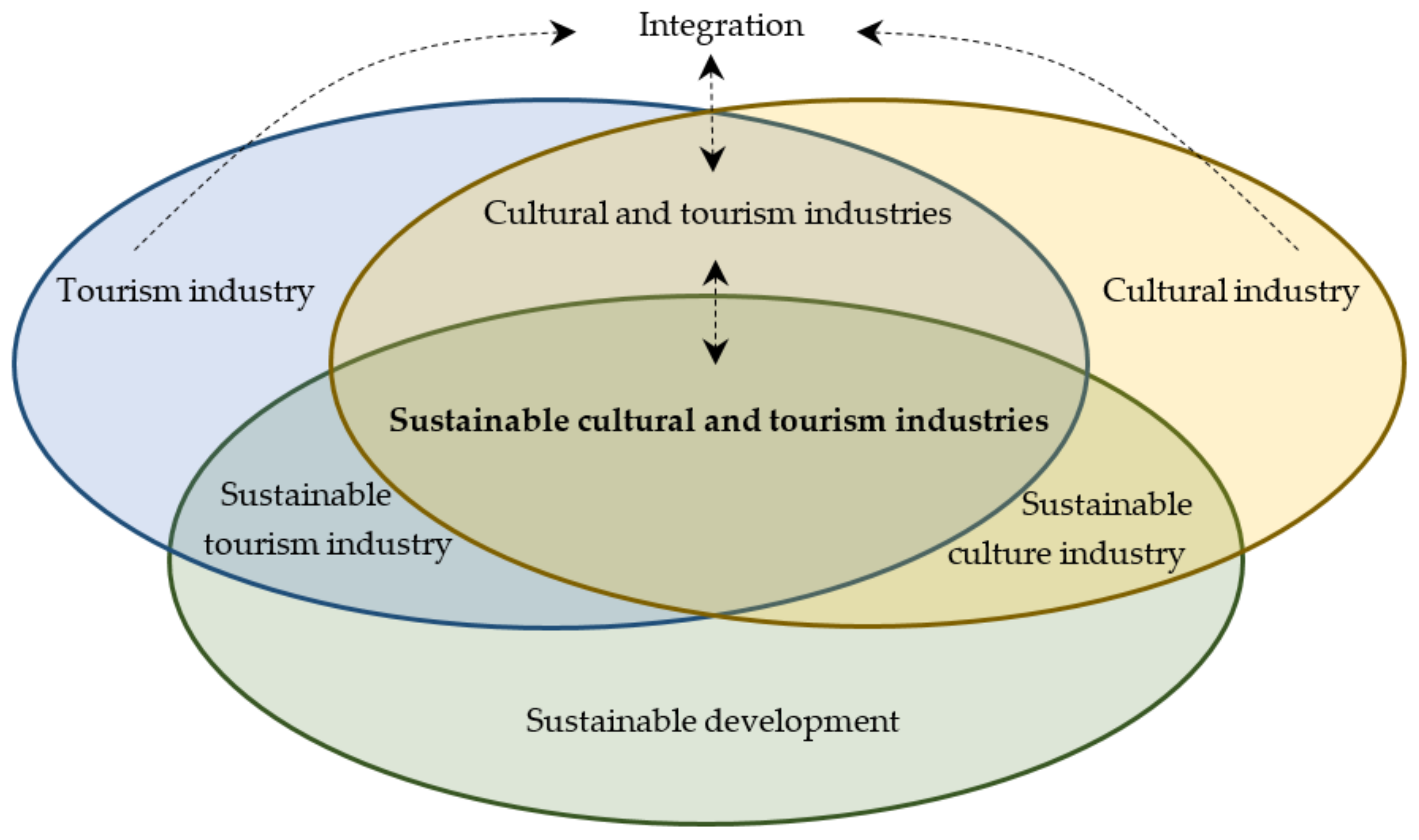
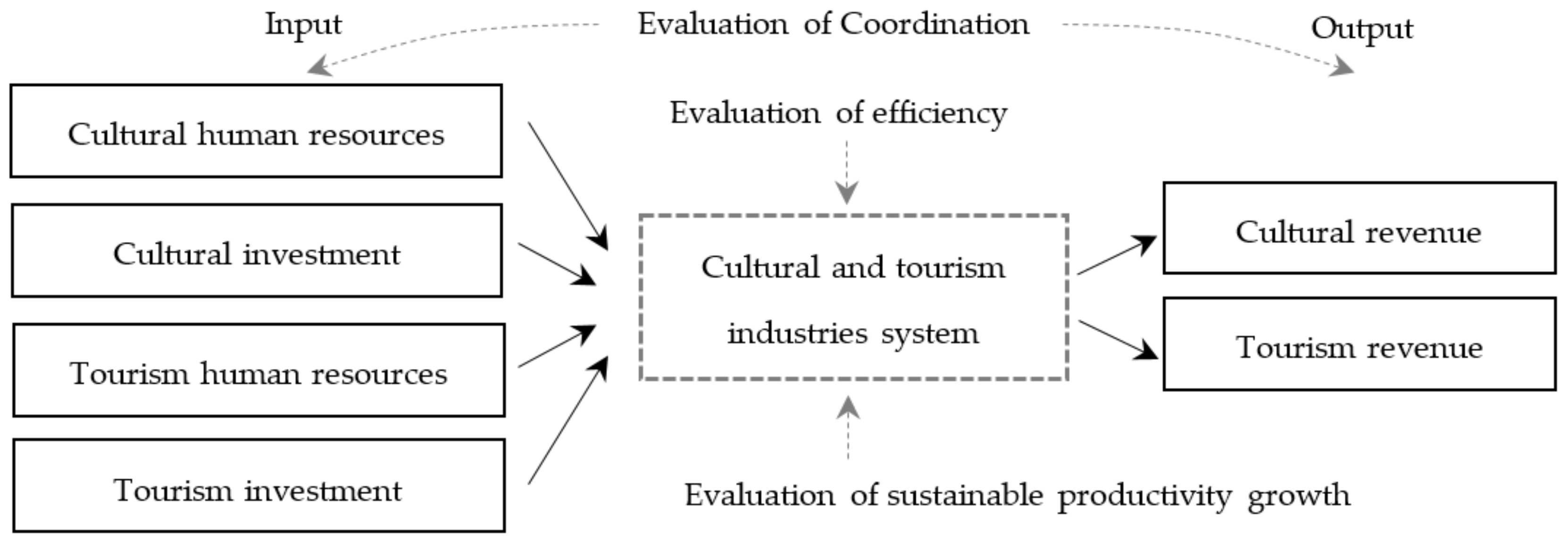

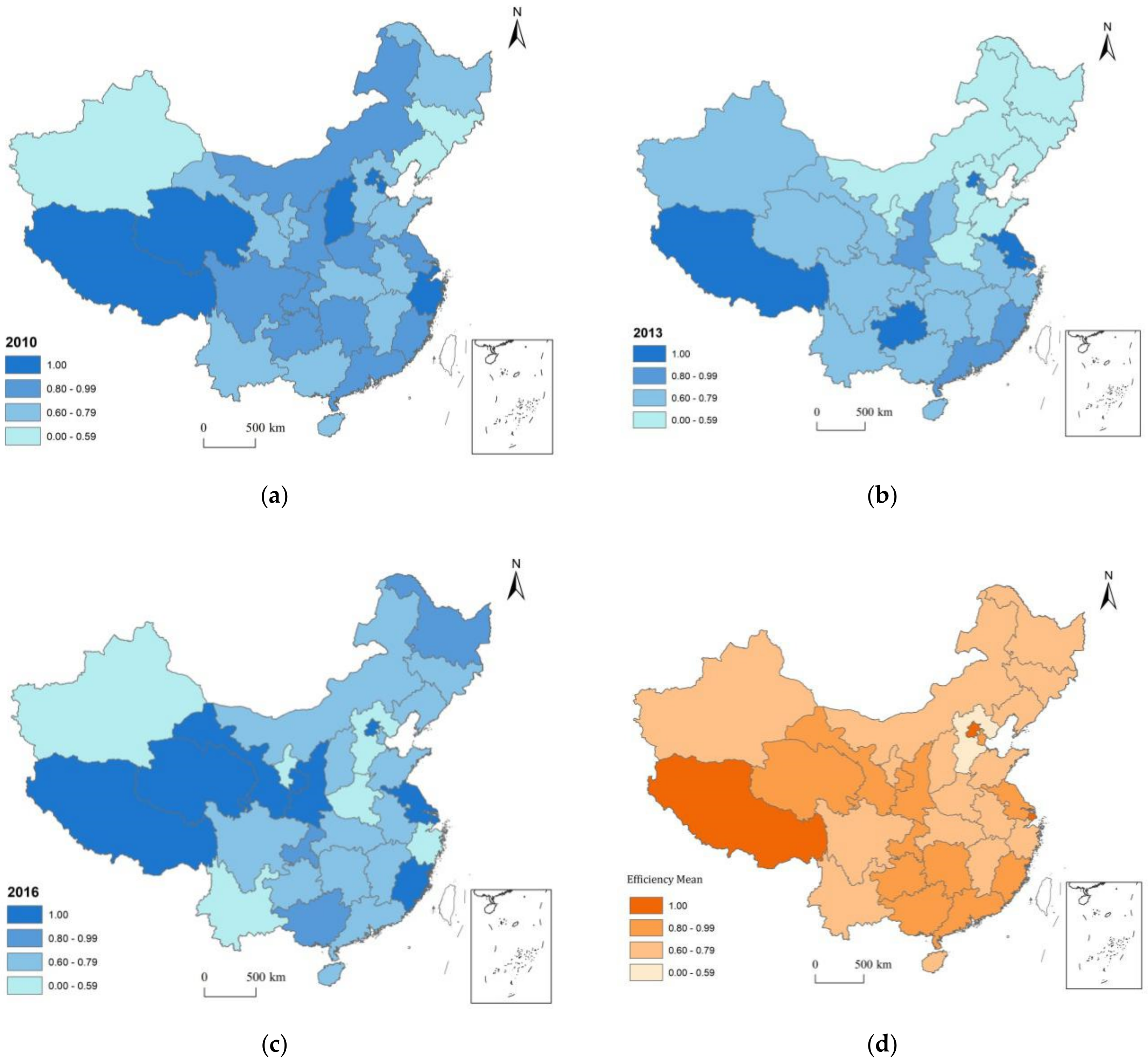

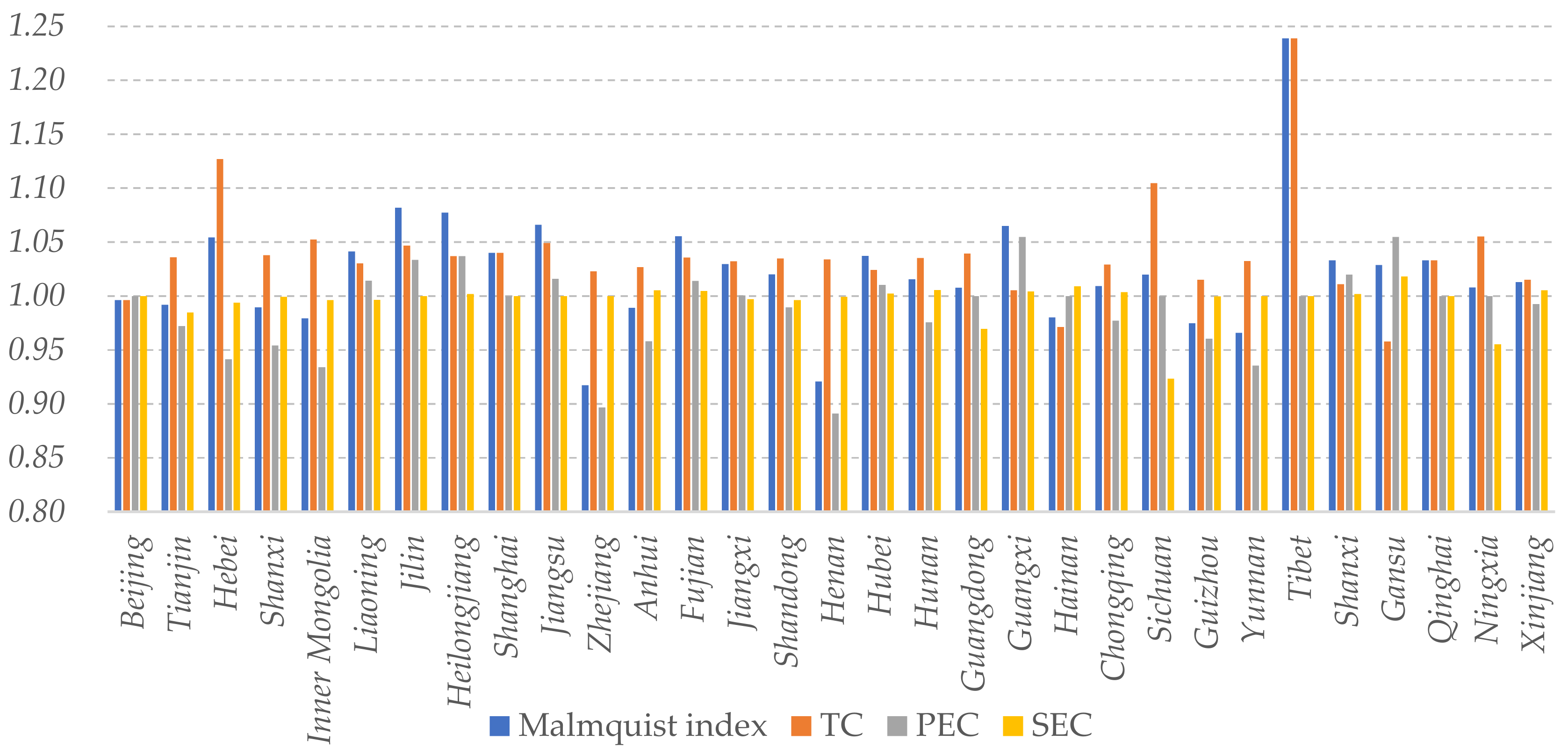
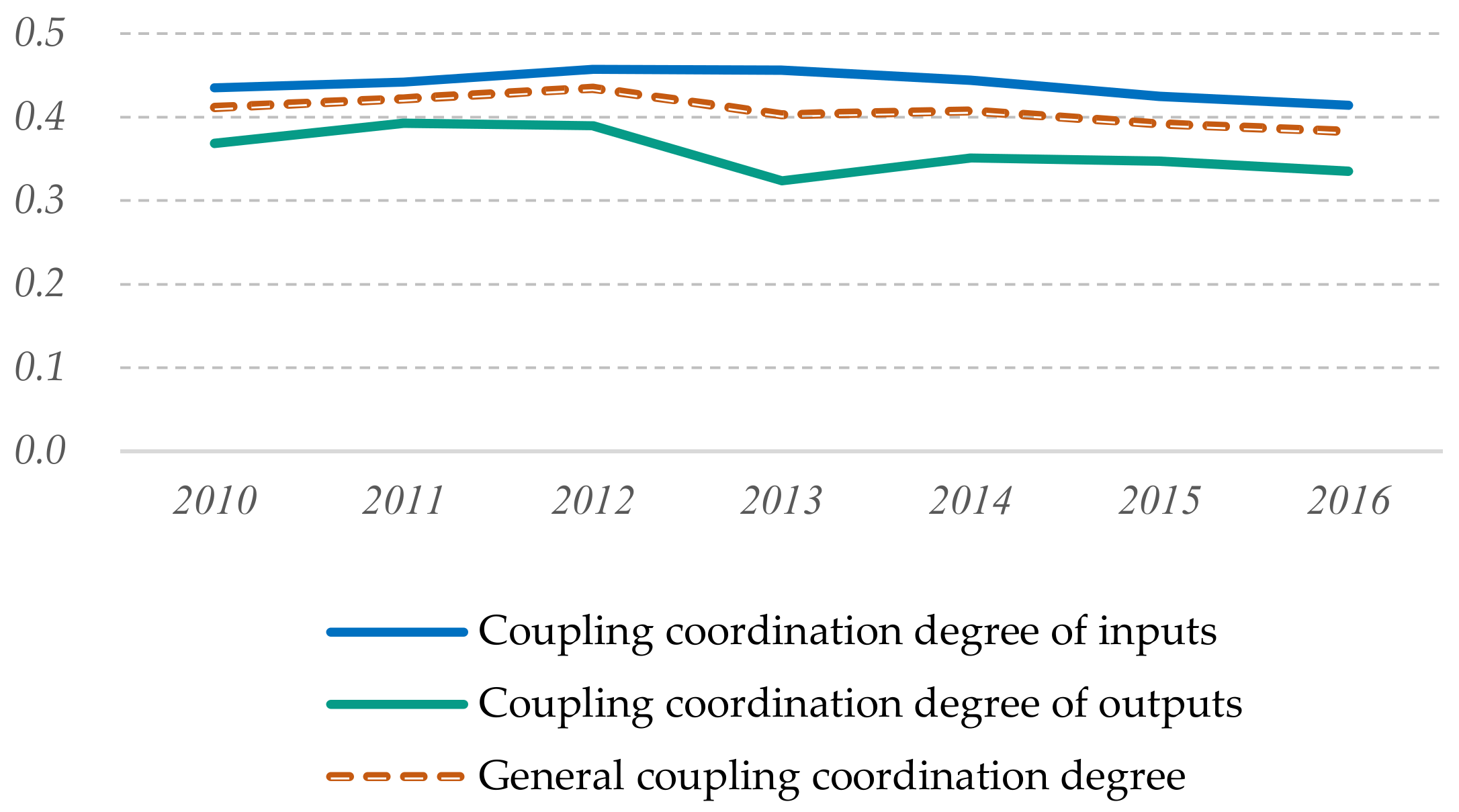
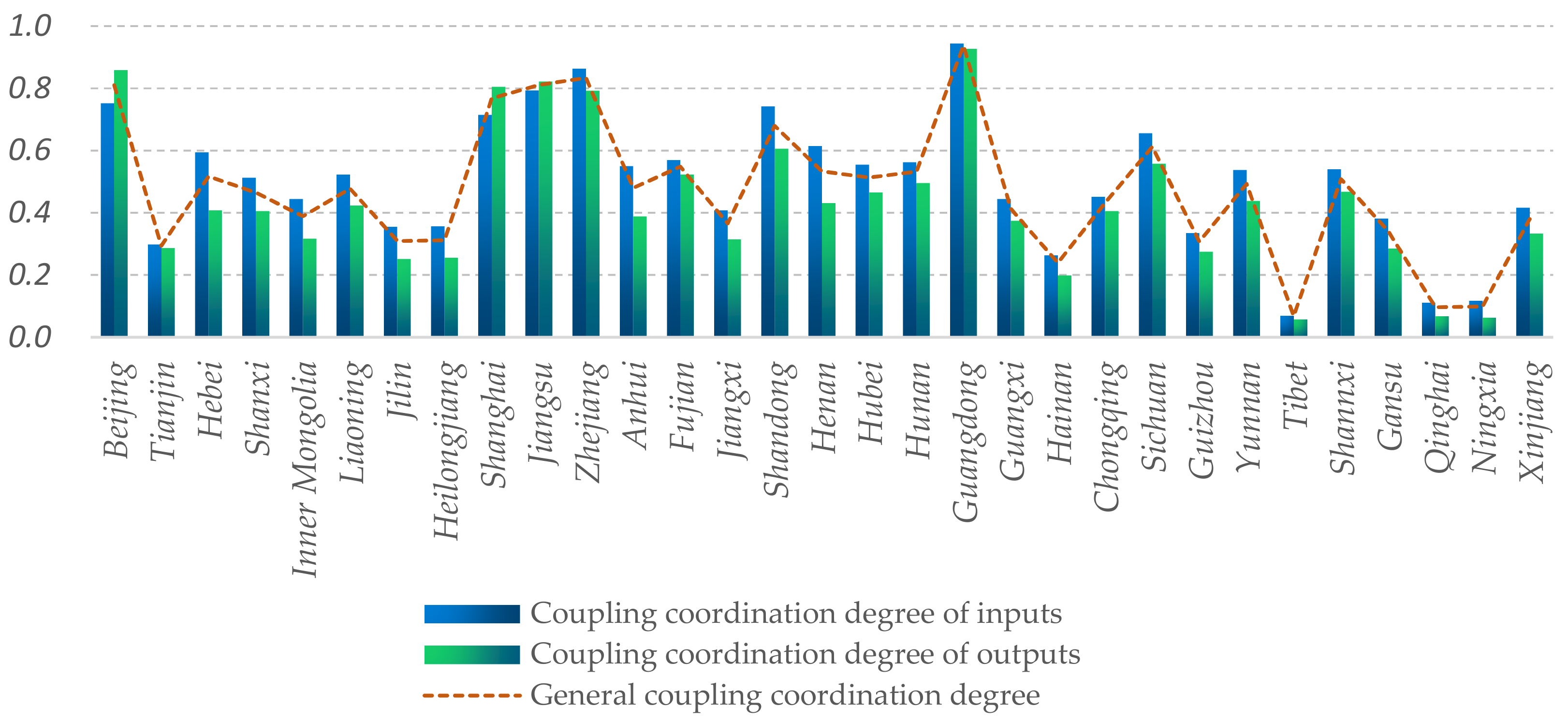
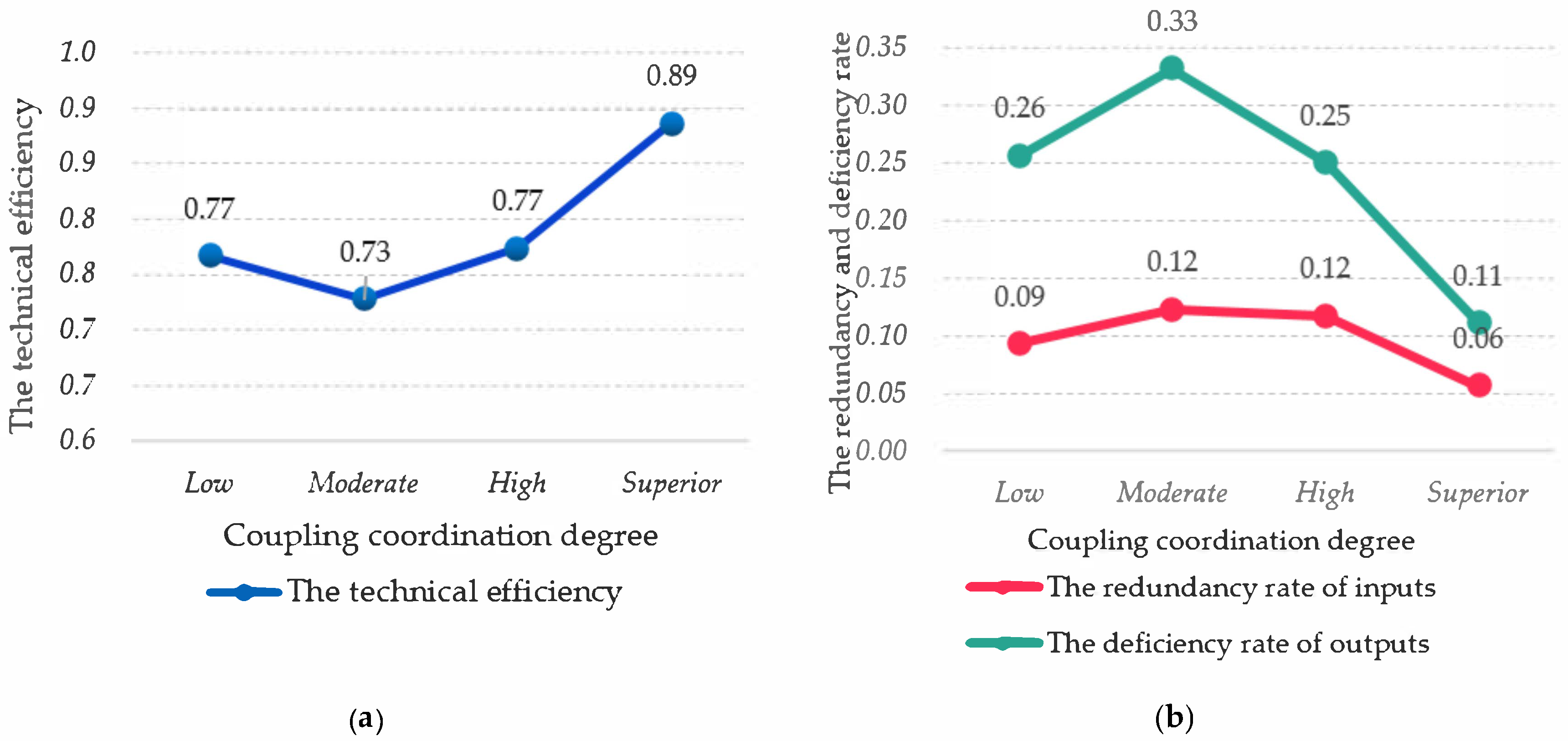
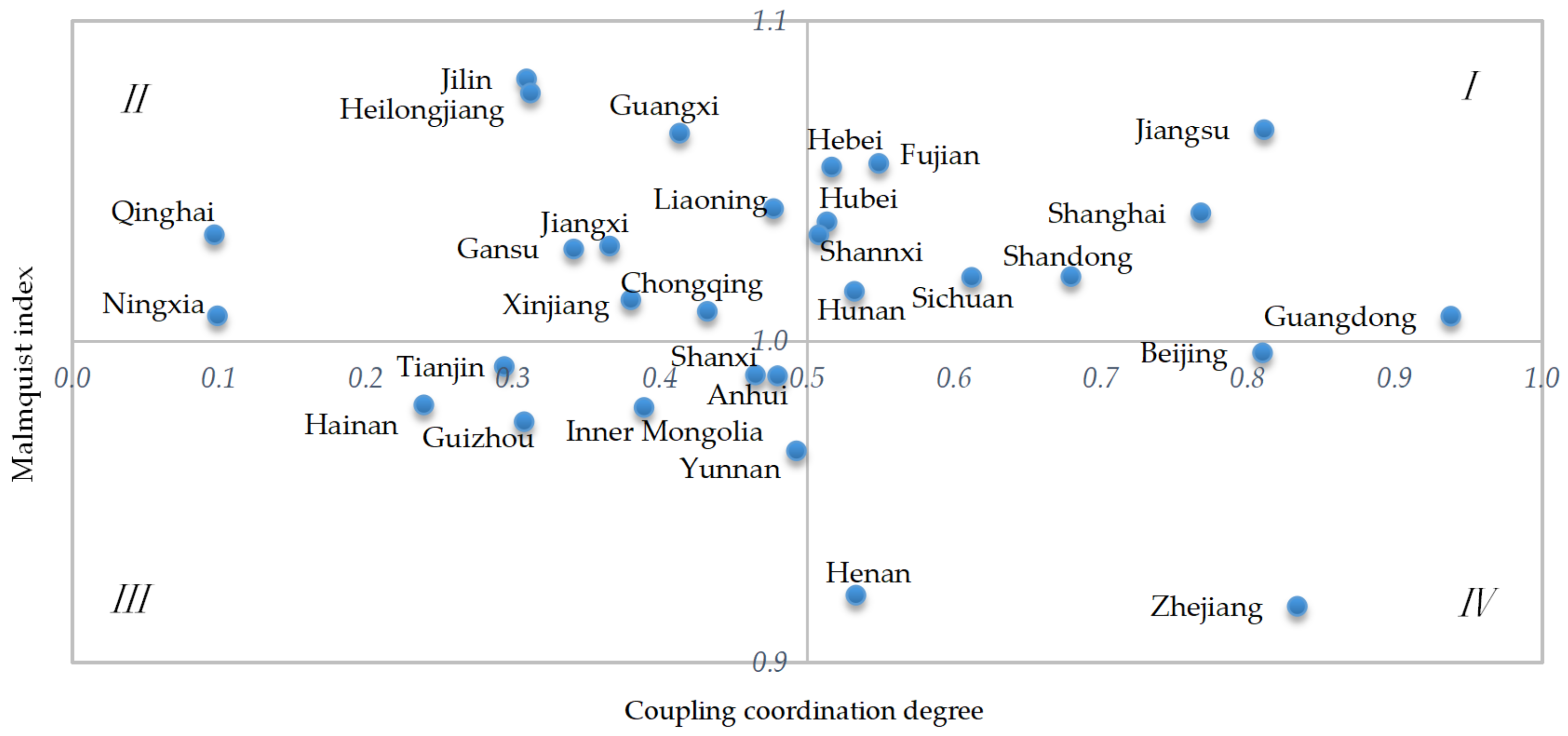
| Efficiency Name | Type | Indicator | Unit |
|---|---|---|---|
| CTI Efficiency | Input | Tourism Investment | 10,000 CNY |
| Tourism Human Resources | Person | ||
| Cultural Investment | 10,000 CNY | ||
| Cultural Human Resources | Person | ||
| Output | Tourism Revenue | 10,000 CNY | |
| Cultural Revenue | 1000 CNY | ||
| Tourism Industry Efficiency | Input | Tourism Investment | 10,000 CNY |
| Tourism Human Resources | Person | ||
| Output | Tourism Revenue | 10,000 CNY |
| Provinces and Regions | The Redundancy Rate of Input (%) Tourism Industry/CTI | The Deficiency Rate of Output (%) Tourism Industry/CTI | Efficiency of the Tourism Industry/ Efficiency of CTI | ||||
|---|---|---|---|---|---|---|---|
| Cultural Investment | Cultural Human Resources | Tourism Investment | Tourism Human Resources | Tourism Revenue | Cultural Revenue | ||
| Beijing | -/0.0 | -/0.0 | −7.1/0.0 | 0.0/0.0 | 34.0/0.0 | -/0.0 | 0.746/1.000 |
| Tianjin | -/−15.0 | -/−1.9 | 0.0/0.0 | −23.1/−2.8 | 59.2/9.1 | -/0.0 | 0.628/0.953 |
| Hebei | -/−0.1 | -/−53.7 | −18.5/−21.2 | −15.6/−8.9 | 250.3/141.0 | -/0.0 | 0.286/0.573 |
| Shanxi | -/−2.7 | -/−33.3 | 0.0/0.0 | −31.8/−10.5 | 141.0/61.9 | -/0.0 | 0.415/0.756 |
| Inner Mongolia | -/−22.2 | -/−23.0 | 0.0/0.0 | −22.5/−2.3 | 213.2/121.3 | -/6.1 | 0.319/0.598 |
| Liaoning | -/−0.5 | -/−33.1 | 0.0/0.0 | −16.5/−9.3 | 108.4/78.5 | -/31.7 | 0.480/0.623 |
| Jilin | -/−22.8 | -/−24.1 | 0.0/0.0 | −23.1/−2.7 | 218.9/134.6 | -/3.2 | 0.314/0.591 |
| Heilongjiang | -/−23.8 | -/−41.3 | 0.0/0.0 | −24.2/−2.7 | 123.7/72.7 | −/10.6 | 0.447/0.703 |
| Shanghai | -/0.0 | -/0.00 | 0.0/0.0 | 0.0/0.0 | 0.0/0.0 | -/0.0 | 1.000/1.000 |
| Jiangsu | -/0.0 | -/−4.3 | 0.0/0.0 | −15.1/−9.3 | 51.5/5.4 | -/5.7 | 0.660/0.946 |
| Zhejiang | -/−2.8 | -/−29.7 | 0.0/0.0 | −17.0/−8.9 | 66.7/40.8 | −/14.4 | 0.600/0.753 |
| Anhui | -/−1.1 | -/−65.3 | 0.0/0.0 | −27.7/−18.2 | 95.4/56.5 | -/19.6 | 0.512/0.707 |
| Fujian | -/0.0 | -/−27.1 | 0.0/0.0 | −38.8/−25.2 | 16.4/6.5 | -/5.8 | 0.859/0.940 |
| Jiangxi | -/−1.4 | -/−36.7 | 0.0/0.0 | −38.3/−17.4 | 75.3/29.2 | -/19.4 | 0.570/0.789 |
| Shandong | -/0.0 | -/−37.6 | 0.0/0.0 | −23.5/−28.2 | 111.2/76.2 | -/26.6 | 0.473/0.649 |
| Henan | -/−0.5 | -/−56.5 | 0.0/0.0 | −32.7/−14.4 | 144.3/79.9 | -/6.6 | 0.409/0.688 |
| Hubei | -/−4.7 | -/−27.3 | 0.0/0.0 | −23.7/−11.9 | 84.2/53.0 | -/23.4 | 0.543/0.699 |
| Hunan | -/−2.4 | -/−34.7 | 0.0/0.0 | −33.1/−24.3 | 37.8/18.0 | -/11.7 | 0.726/0.861 |
| Guangdong | -/0.0 | -/−2.9 | 0.0/0.0 | −22.2/−28.1 | 26.9/14.9 | -/12.9 | 0.788/0.871 |
| Guangxi | -/−6.9 | -/−2.0 | 0.0/0.0 | −43.0/−29.5 | 80.0/37.5 | -/5.9 | 0.556/0.819 |
| Hainan | -/0.0 | -/−24.0 | 0.0/−12.0 | −13.0/−25.0 | 108.8/38.1 | -/24.4 | 0.479/0.749 |
| Chongqing | -/−1.2 | -/−17.6 | 0.0/0.0 | −25.7/−12.4 | 34.8/12.7 | -/21.7 | 0.742/0.841 |
| Sichuan | -/−6.8 | -/−17.5 | −2.1/−2.5 | −10.5/0.0 | 139.3/69.8 | -/0.8 | 0.418/0.728 |
| Guizhou | -/−8.3 | -/−11.7 | 0.0/0.0 | −43.0/−11.2 | 98.3/12.2 | -/0.5 | 0.504/0.937 |
| Yunnan | -/−0.3 | -/−29.8 | 0.0/0.0 | −23.6/−18.7 | 98.9/69.8 | -/28.5 | 0.503/0.646 |
| Tibet | -/0.0 | -/0.00 | −4.7/0.0 | −6.3/0.0 | 324.6/0.0 | -/0.0 | 0.236/1.000 |
| Shannxi | -/−1.1 | -/−3.5 | 0.0/0.0 | −33.2/−3.8 | 98.7/9.5 | -/2.6 | 0.503/0.942 |
| Gansu | -/−1.9 | -/−19.6 | 0.0/0.0 | −33.7/−10.5 | 195.8/26.2 | -/0.0 | 0.338/0.873 |
| Qinghai | -/−9.0 | -/0.00 | 0.0/0.0 | −30.7/−1.0 | 182.3/8.4 | -/0.0 | 0.354/0.955 |
| Ningxia | -/−7.8 | -/−11.3 | −0.5/−2.2 | −15.3/−6.2 | 200.6/108.8 | -/0.7 | 0.333/0.637 |
| Xinjiang | -/−8.9 | -/−16.0 | 0.0/0.0 | −21.3/−5.9 | 182.7/128.8 | -/2.6 | 0.354/0.597 |
© 2019 by the authors. Licensee MDPI, Basel, Switzerland. This article is an open access article distributed under the terms and conditions of the Creative Commons Attribution (CC BY) license (http://creativecommons.org/licenses/by/4.0/).
Share and Cite
Su, Z.; Aaron, J.R.; McDowell, W.C.; Lu, D.D. Sustainable Synergies between the Cultural and Tourism Industries: An Efficiency Evaluation Perspective. Sustainability 2019, 11, 6607. https://doi.org/10.3390/su11236607
Su Z, Aaron JR, McDowell WC, Lu DD. Sustainable Synergies between the Cultural and Tourism Industries: An Efficiency Evaluation Perspective. Sustainability. 2019; 11(23):6607. https://doi.org/10.3390/su11236607
Chicago/Turabian StyleSu, Zhen, Joshua R. Aaron, William C. McDowell, and Dan Dan Lu. 2019. "Sustainable Synergies between the Cultural and Tourism Industries: An Efficiency Evaluation Perspective" Sustainability 11, no. 23: 6607. https://doi.org/10.3390/su11236607
APA StyleSu, Z., Aaron, J. R., McDowell, W. C., & Lu, D. D. (2019). Sustainable Synergies between the Cultural and Tourism Industries: An Efficiency Evaluation Perspective. Sustainability, 11(23), 6607. https://doi.org/10.3390/su11236607







